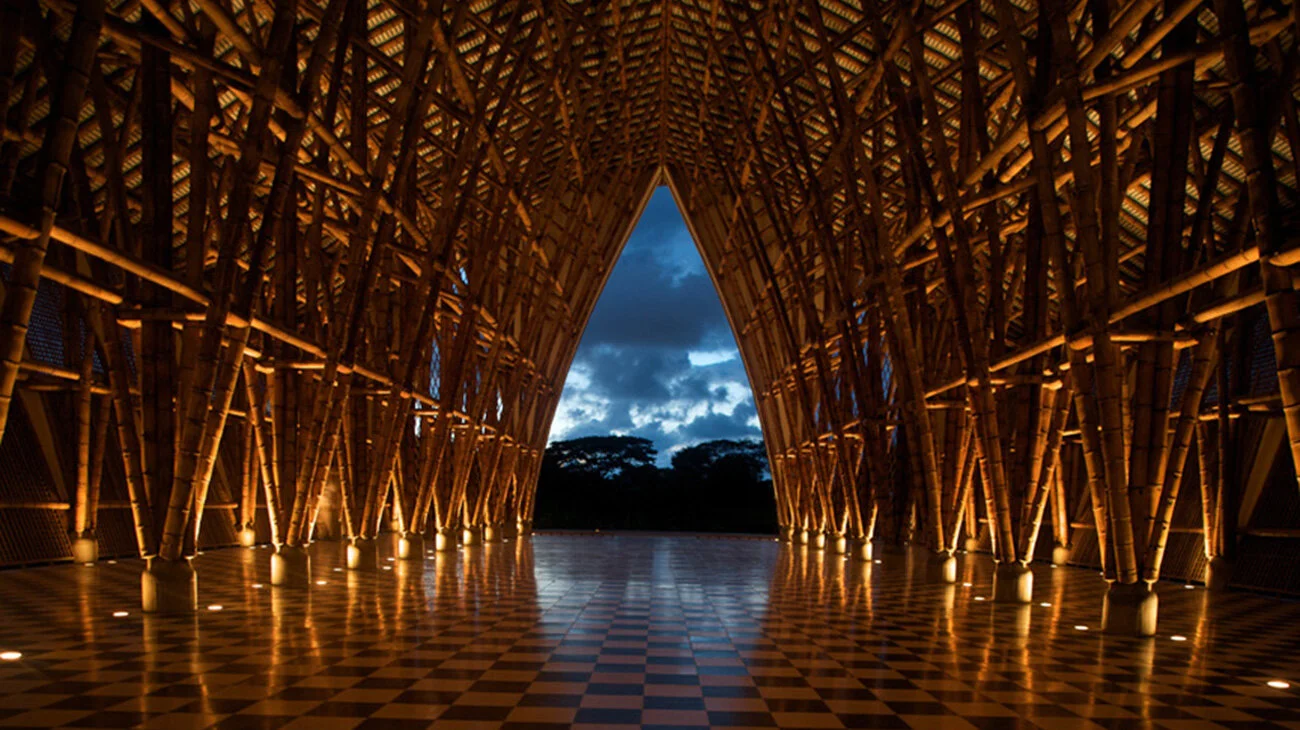Simón Vélez
We had the pleasure of meeting Colombian architect Simón Vélez and touring his compound in the La Candelaria district of Bogotá— a historic neighborhood filled with Spanish Colonial and Baroque buildings. His sprawling home is tucked away on a steep street lined with artistic graffiti, and features the Guadua bamboo joinery his architecture firm has become renowned for.
Vélez has completed works around the world, including: Arles, France; Islas Secas, Panama; Shanghai, China; Cartagena, Colombia; Mexico City, Mexico; Guangzhou, China; Pereira, Colombia; Ochorios, Jamaica; Hannover, Germany; Pereira, Colombia; and his hometown of Bogota, Colombia. He has participated in the Biennale di Venezia, the Shanghai EXPO, and was the recipient of the Award of Honor from the American Society of Landscape Architects, and the prestigious Dutch Prince Claus Award.
Today, Simón sits down with us and shares more about his practice and personal life.
Where are you from originally? I was born in Manizales, Colombia where the coffee grows, and there is bamboo everywhere. The city was founded 163 years ago. The year I was born was the centenary, it was 100 years old. Manizales was the second city in Colombia in economic activity, because of the coffee and because of the gold. The houses were really beautiful, but then came a huge fire and everything was destroyed because it was a wooden city. They started to rebuild the city with concrete imported from Denmark and the U.S., but it was never the same. There were not architects during my grandfather’s times, but his business was construction, so he built many houses in Manizales. I come from the family that founded Manizales.
What do you enjoy about living in Bogotá now? I live in the historic center of Bogota and I have a large garden. Living here I feel like I am in a small village. My house is the result of architecture without an architect. It has been developed for years. It’s a family hamlet.
Where did you study? I consider myself a self-taught architect. I studied architecture at a very bad private university in Bogota, Colombia— Los Andes is the name, very close to here, but I was never interested in that kind of architecture. I was never interested in modern architecture because I grew up in a modern house. I appreciate what my father built, but I don’t belong to that. I was always interested in vernacular architecture.
Did you always want to become an architect? Yes, I have always wanted to be an architect. Both of my grandfathers were builders, and my father was an architect as well as my mentor. He studied at Catholic University in Washington DC. In 1968 many things happened in the world that changed the minds of all the young people. I was 19 years old when Woodstock happened. For that reason, I can say I have a hippie attitude, and I always wanted to work with natural materials. I was kind of a hippie, but I am a hippie who plays golf, and who doesn’t smoke marijuana, but I was influenced by that attitude.
How did you first encounter Bamboo as a material? I grew up in an area with native bamboo growing everywhere, but it had a stigma as being the wood of the poor. A client, around 40 years ago, forced me to work with bamboo. At that point, I was working mainly with wood, but with this project, I discovered how to do the proper joinery with bamboo that allowed me to make very big structures.
Who or what inspires you? Traditional vernacular architecture. After traveling around the world, I realized that the only nice architecture is vernacular architecture. The only thing that impresses me; it doesn’t matter where in the world, is the vernacular architecture. Natural is everything for me. Steel is a natural material, and stone; I love stone. In my next life, if it exists, I want to be a stone architect. I really love stones. Ever since I was at university, I was always interested in doing countryside architecture. I was never interested in urban architecture. We are a culture of farmers after all.
Where do you dream of traveling next? I love Brazil, I have been many times and it is a huge country. There is a lot to see.
What is your favorite Colombian hotel or resort? Hacienda Venecia in Chinchina near Manizales where I was born. It is a working coffee plantation and hotel.
What are your favorite local cafes and bars in Bogotá? Prudencia and La Brasserie.
What are your favorite museums? The Gold Museum in Bogotá has an excellent collection, but the building is very ugly.
Where are your favorite places to shop in Bogota? Artesenias de Colombia and their annual Christmas Fair.
Do you cook? Don’t make me laugh. I can make coffee.
What do you do with your free time? I play golf.
What is next for you? 2020 was a very hard year, a year to forget. But now things are coming back to life. My wife and design partner, Stefana Simic, have an ongoing project in Qatar and that project is being presented in Venice at the Biennale of Architecture this year. Besides that, I have work in Brazil, Mexico, and in Colombia. We are also preparing to repeat the Contemplation Project in Paris, France next year. This project was already assembled in Arles, France in 2018 for the Mathieu Ricard photography exhibition.
Text: Veronica H. Speck Photo: Pedro Franco







